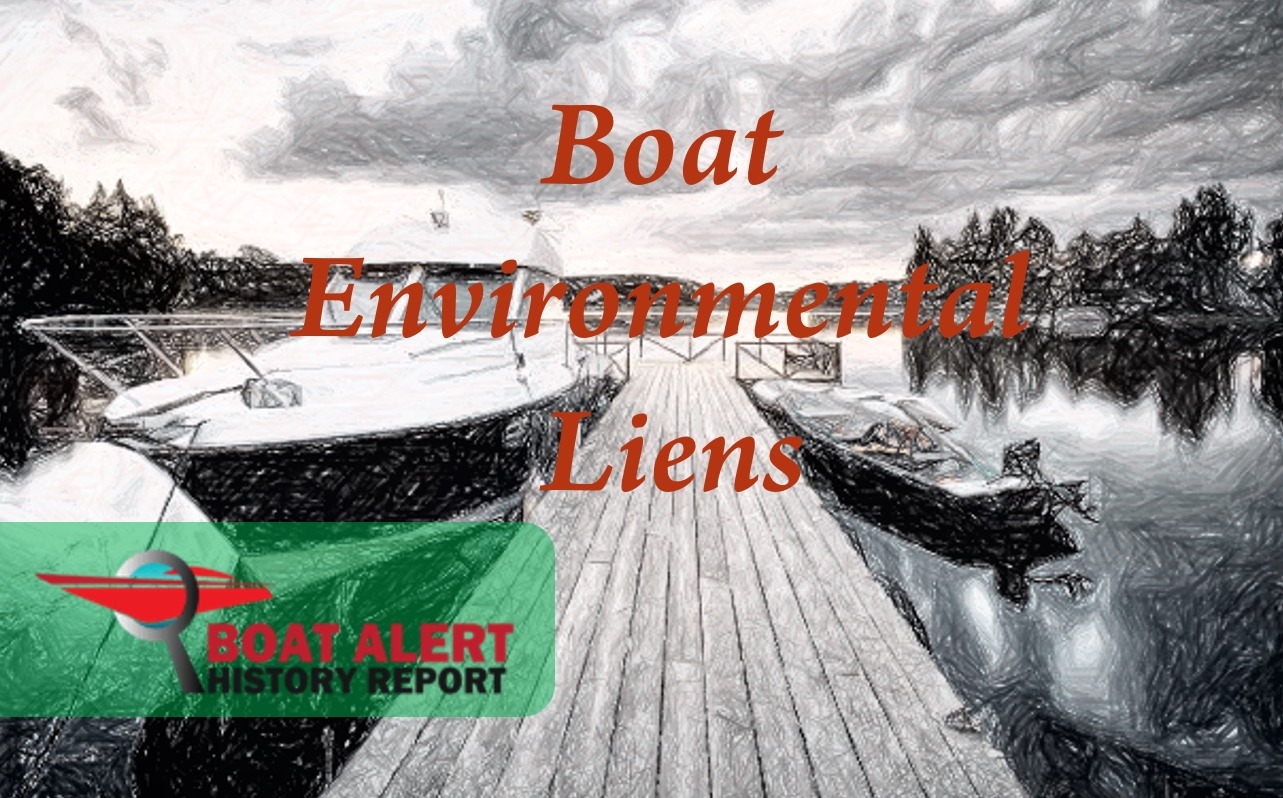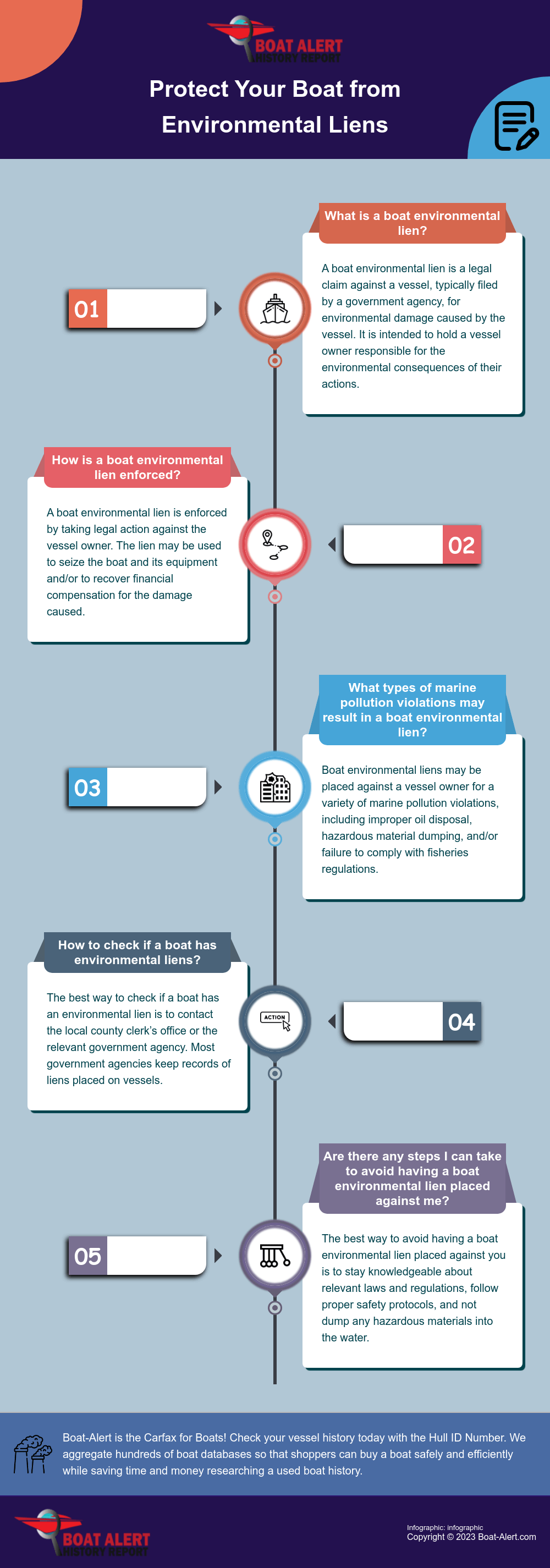What is an Environmental Lien on a vessel?

Table of Contents
Environmental Lien on a Vessel: Protecting the Environment through Legal Mechanisms
In an era marked by increasing concern for the environment, governments and regulatory bodies have been actively pursuing measures to protect natural resources and hold individuals and corporations accountable for their actions. One such measure is the concept of an environmental lien on a vessel, a legal mechanism designed to ensure compliance with environmental regulations and to address the financial responsibilities associated with environmental damage caused by a vessel. In this article, we delve into the concept of an environmental lien on a vessel and explore its significance in safeguarding the environment.
Understanding Vessel Environmental Liens
An boat environmental lien on a vessel is a legal claim placed on a vessel to secure the payment of fines, penalties, and cleanup costs associated with environmental violations or damage caused by the vessel. It serves as a means of holding vessel owners or operators financially accountable for any harm caused to the environment through their activities.
Environmental liens (security interests) are typically imposed by government agencies or other authorized entities that have the power to enforce environmental regulations. These entities may include environmental protection agencies, coast guards, or other relevant bodies responsible for overseeing maritime activities.
Since it isn’t possible for someone living in a remote area to travel to the vessel’s home port to establish a lien. Therefore, maritime law effectively assumes that a lien is created as soon as the money is owed. No paperwork is needed. Nor does the owner of the boat need to receive notice, hence the “secret liens” or “hidden liens”.
A secret lien has no effect until the holder goes into federal court where maritime matters are handled. When a judgement is filed against a boat, a U.S. Marshal is sent to “arrest” the craft. While the boat is not handcuffed or put in jail, it does get a brightly colored sticker that makes it a federal crime to move the vessel until the payment is made.
The Purpose of Environmental Liens
The primary objective of imposing an environmental lien on a vessel is to ensure that the responsible parties fulfill their obligations to mitigate environmental damage and cover associated costs. By placing a lien on the vessel, authorities can prevent its sale or transfer until the outstanding financial liabilities are resolved.
This mechanism acts as a powerful deterrent, encouraging vessel owners and operators to comply with environmental regulations and adopt best practices to prevent environmental harm. Moreover, it provides a means for governments to swiftly recover costs incurred in cleaning up pollution or responding to environmental emergencies, reducing the burden on taxpayers and protecting public resources.
You can also search UCC liens and the vessel title.
Implications of Environmental Liens
The presence of environmental liens on a boat has serious implications for both the vessel itself and its owner. Federal agents have the authority to seize a boat with an environmental lien at any time until the financial obligations have been satisfied. This means that the boat may be taken into custody and prevented from being operated or sold until the outstanding payments have been settled.
Transferring Liabilities under Admiralty Law
If you are considering purchasing a boat with an environmental lien, it is crucial to understand the potential financial responsibilities involved. In cases where the previous owner of the boat has not paid off their debt before selling the vessel to you, the burden of payment now falls on your shoulders as the new owner.
Under admiralty law, a boat is considered a separate legal entity, distinct from its registered owner. As a result, all fines and liens, including environmental liens, are transferred with the boat itself, rather than the previous owner. Therefore, it is essential to thoroughly investigate the status of any environmental liens associated with a boat before purchasing it to avoid inheriting substantial financial obligations.
Imposition and Enforcement of Environmental Liens
The process of imposing and enforcing an environmental lien on a vessel involves several steps. It begins with the identification of an environmental violation or damage caused by a vessel. Once the responsible party has been determined, the relevant government agency or regulatory body initiates the lien process.
Typically, a notice of intent to impose a lien is sent to the vessel owner or operator, informing them of the outstanding financial obligations and the consequences of non-compliance. The notice outlines the specific violations, the amount of fines or penalties owed, and any costs associated with environmental cleanup.
If the responsible party fails to respond or address the outstanding obligations within a specified timeframe, the government agency may proceed with the formal imposition of the lien. This involves filing a legal claim against the vessel in a court of law, effectively encumbering it and preventing its sale or transfer until the financial obligations are satisfied.
Resolving Environmental Liens
To release an environmental lien on a vessel, the responsible party must fulfill their financial obligations. This typically involves paying the fines, penalties, and cleanup costs in full. Upon receipt of payment, the government agency or regulatory body responsible for the lien issues a release of lien, thereby removing the encumbrance on the vessel.
In some cases, alternative arrangements may be made to satisfy the financial obligations. For example, the responsible party may negotiate a payment plan with the enforcing agency or provide an acceptable form of financial security, such as a bond or letter of credit, to cover the outstanding liabilities.
To avoid buying a boat with an environmental lien, consider the following tips:
- Research the boat’s history: Conduct thorough research on the boat’s history, including any previous owners, accidents, or environmental incidents. Request documentation such as maintenance records, inspection reports, and insurance claims. This information can provide insights into the vessel’s past and help identify any potential environmental issues. You can do this with the hull identification numbers checkup.
- Obtain a marine survey: Hire a professional marine surveyor to assess the boat’s condition, systems, and overall seaworthiness. A surveyor can identify any hidden problems, including environmental damage, that may not be immediately apparent. Ensure the surveyor is experienced in evaluating environmental concerns.
- Consult with maritime professionals: Seek advice from knowledgeable professionals in the maritime industry, such as boat brokers, maritime attorneys, or environmental consultants. They can guide you through the buying process and help you navigate potential environmental risks associated with a particular vessel. Your boat broker should be able to validate the boat.
- Check for Coast Guard documentation: If the boat is registered with the United States Coast Guard, you can search their database for any recorded liens. This database can provide valuable information about the vessel’s ownership history and any encumbrances or liens.
- Review public records: Research local, state, and federal databases for any environmental violations (penalty) or enforcement actions associated with the boat or its previous owners. This can include records from environmental agencies, Coast Guard reports, or court documents. These sources can reveal if the boat has been involved in any environmental incidents that may lead to an environmental lien or claimants.
- Conduct a title search: Perform a comprehensive title search to ensure there are no outstanding liens, including environmental liens, on the boat. Engage the services of a professional title company or an attorney specializing in maritime law to assist you with this process.
- Purchase boat insurance: Obtain comprehensive boat insurance coverage that includes environmental liability protection. Verify with the insurance provider that the policy covers any potential environmental claims resulting from previous owner actions or incidents. This can provide financial protection in case an environmental lien surfaces after the purchase.
- Seek legal advice: If you have concerns about potential environmental liens or are unsure about the boat’s history, consult with a maritime attorney who specializes in environmental law. They can provide legal guidance, review documentation, and ensure that you’re fully informed about any potential risks associated with the vessel. An affidavit from the seller that they don’t have a lien would be good.
Other types of vessel liens
Here’s a table listing different kinds of boat liens
| Lien Type | Description |
|---|---|
| Maritime Lien | A lien that arises from services or goods provided to a vessel, including salvage, repairs, or supplies. |
| Mortgage Lien | A lien placed on a boat to secure a loan used for its purchase. |
| Tax Lien | A lien imposed by a government entity for unpaid taxes or fees related to the boat. |
| Mechanic’s Lien | A lien filed by a boat repair or maintenance professional for unpaid bills or services rendered. |
| Storage Lien | A lien held by a marina or storage facility for unpaid fees related to the storage of a boat. |
| Judgment Lien | A lien resulting from a court judgment against the boat owner, typically related to a debt or dispute. |
| Construction Lien | A lien filed by a boat builder or contractor for unpaid construction or improvement work on the vessel. |
| Involuntary Lien | A lien imposed by law without the boat owner’s consent, such as a tax lien or judgment lien. |
| Voluntary Lien | A lien created voluntarily by the boat owner, often to secure a loan or line of credit. |
| Preferred Ship Mortgage Lien | A lien on a documented vessel that has priority over other liens, often associated with vessel financing. |
| Environmental Lien | A lien imposed due to environmental violations or damages caused by the boat, such as pollution. |
Conclusion
An environmental lien refers to a legal claim imposed on a vessel that has caused harm to the environment. When a boat causes environmental damage, such as damaging coral reefs or sea grass, substantial fines may be imposed, often exceeding $100,000. These fines are then placed on the boat as environmental liens. The presence of environmental liens allows federal agents to seize the boat at any time until the outstanding payment is resolved.
If you intend to purchase a boat that has an environmental lien, it’s essential to be aware that if the previous owner fails to settle the debt before selling you the boat, the responsibility for payment now falls on your shoulders. According to admiralty law, a boat is considered a separate entity, meaning that all fines, including environmental liens, are transferred with the boat rather than the registered owner.
To safeguard yourself in such situations, it is advisable to obtain a Boat Alert History Report, which provides valuable information about the boat’s past and potential liens or outstanding debts. We check many lien databases but not all.
Environmental liens on vessels play a vital role in promoting environmental responsibility and ensuring accountability in the maritime industry. By imposing these liens, governments and regulatory bodies can effectively deter environmental violations, encourage compliance with regulations, and expedite the recovery of costs associated with environmental damage.
#boat #lien #environmental #environmentallien #vessel
Read Related Articles:
- Discontinued Boat Manufacturers List
- What is an Environmental Lien on a vessel?
- Rhode Island Boat Registration
- Best Marine Surveyors in Annapolis
- How to Register a Boat in Newfoundland | Vessel Licensing and Registration in Newfoundland

Categories: To learn more about Boat-Alert.com History Reports for used boats and hin search visit: www.Boat-Alert.com